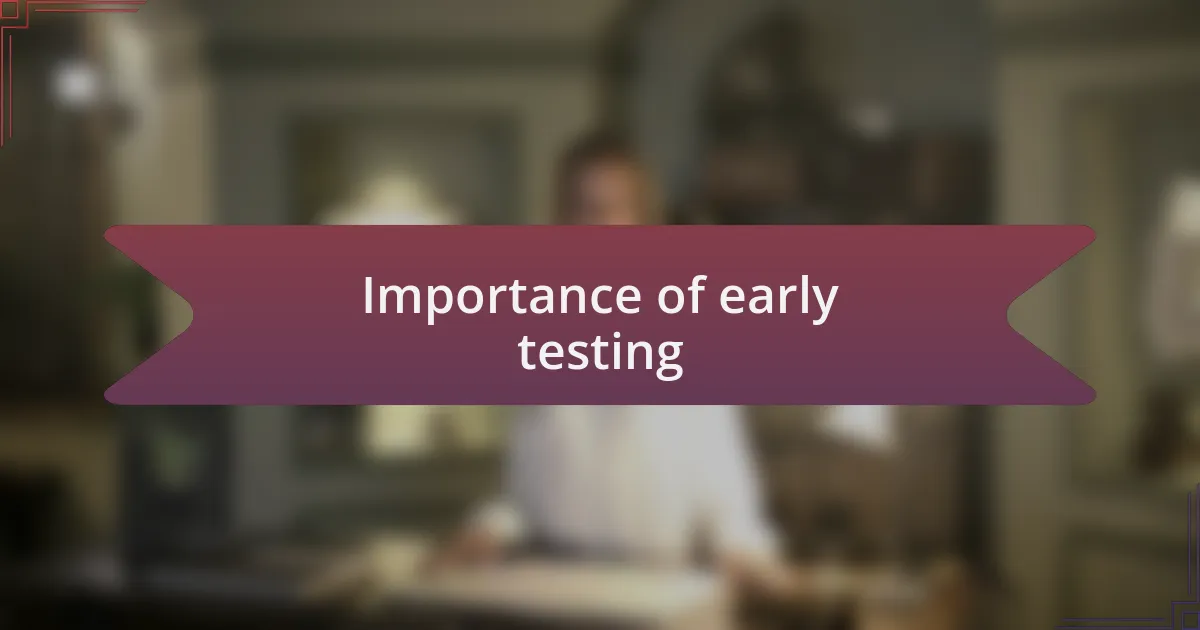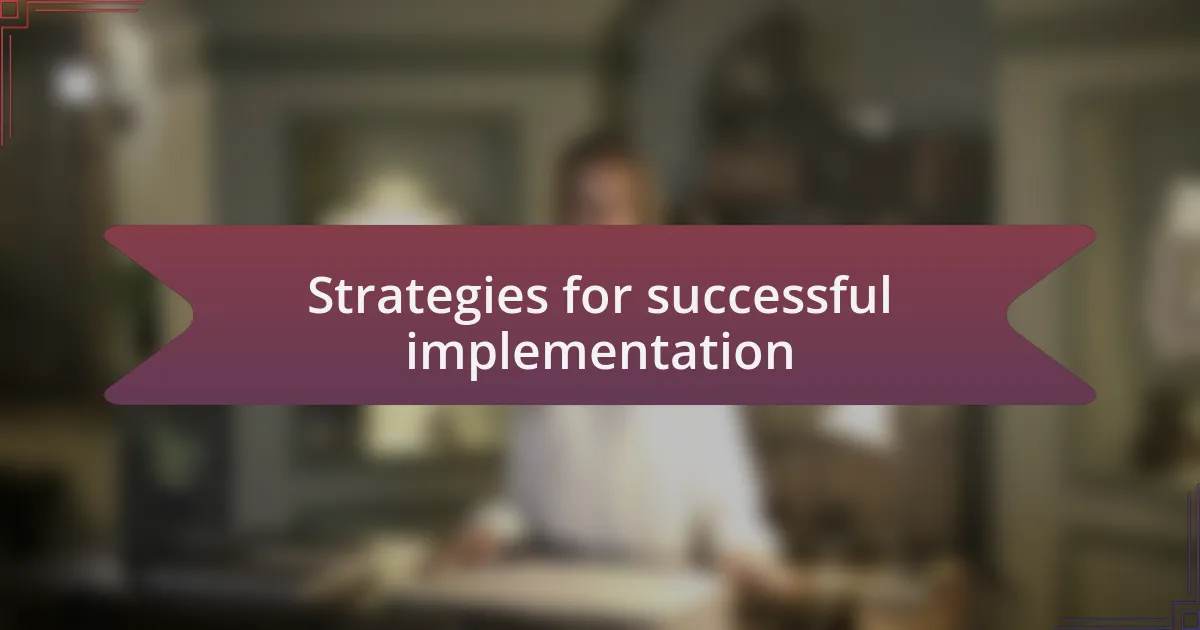Key takeaways:
- Shifting left in testing involves integrating testing early in the software development lifecycle, enhancing code quality and collaboration.
- Early testing helps identify defects before they escalate, fostering richer discussions about requirements and improving team communication.
- Implementing tools like CI/CD and static code analysis aids in catching issues early and streamlining workflows, leading to cost savings and innovation.
- Successful implementation requires a culture of collaboration, regular cross-functional meetings, and ongoing education to promote shared ownership and accountability.

Understanding shifting left in testing
Shifting left in testing is all about involving testing early in the software development lifecycle. I remember a project where we integrated testing within the sprint planning phase, rather than relegating it to the end. This proactive approach not only enhanced our code quality but also fostered a culture of collaboration among developers and testers, ultimately reducing the number of last-minute issues.
Have you ever faced the frustration of a software release delayed due to unexpected bugs? Shifting left can dramatically minimize that angst. By bringing testing activities forward, I found we could catch issues as they arose, making the debugging process feel less like a sprint against the clock and more like a continuous refinement.
Adopting a shift-left strategy also means rethinking how we perceive our testing tools and practices. For instance, implementing automated tests early in the development phase transformed our workflow. It provided immediate feedback, which not only eased my mind but also empowered the team to innovate without the looming fear of hidden flaws. Isn’t it liberating to know that quality can be woven into the very fabric of our development process?

Importance of early testing
Early testing is crucial because it allows us to identify defects before they escalate into major issues. I recall a time when we introduced unit testing during the initial coding phase of a project. The moment we started receiving feedback on our code, I was amazed at how much that simple step reduced our debugging time later on. It was thrilling to witness a smooth workflow emerge, proving that addressing problems early pays off.
I often think about the times I felt overwhelmed by the pressure to meet tight deadlines. The best antidote was always early testing, which gave me the confidence to tackle challenges head-on. By incorporating testing from the get-go, I learned that our team forged richer discussions about requirements and design. It felt like we were not just delivering software, but crafting something robust with longevity.
Moreover, involving testing early creates a shared responsibility across the team. Once, we had a developer come up with a brilliant feature only to realize it created compatibility issues down the line. That experience taught us a valuable lesson about prioritizing collaboration and communication during development. Isn’t it encouraging to discover that when everyone is invested in quality from the beginning, the end result is not just software but a true reflection of our collective dedication?

Benefits of shifting left
One of the most significant benefits of shifting left is the reduction of overall project costs. I remember a project where we caught a critical bug early on that would have been costly to fix later. It reinforced my understanding that identifying and resolving issues sooner can save both time and resources, freeing the team to focus on innovation rather than firefighting.
Shifting left also fosters a culture of quality and collaboration. I can’t count how many times a simple brainstorming session about our test plans led to stronger design solutions. When all team members, from developers to product managers, contribute to testing discussions, it creates a unified vision for quality. Isn’t it exciting to see how this collective approach can transform a project from being just another task to something we all take pride in?
Additionally, early testing creates invaluable learning opportunities. I once participated in a team retrospective where we analyzed our early tests’ results. The insights we gained led to improvements not only in our current project but also influenced our long-term development practices. Each lesson makes me wonder—what if we could harness this understanding every time we shift left? The potential for growth is incredibly empowering.

Tools for shifting left
When considering tools for shifting left, several options stand out in my experience. For instance, I’ve found that static code analysis tools like SonarQube can alert developers to potential issues before the code even runs. It’s like having a vigilant partner who spots flaws early, allowing the team to refine quality right from the start. Have you ever had a tool catch a mistake you were about to overlook? That moment of realization can be both humbling and enlightening.
Continuous integration/continuous deployment (CI/CD) tools play a crucial role too. Tools like Jenkins or CircleCI streamline the process of integrating code changes and automating tests. I recall a time when our adoption of CI/CD dramatically reduced our deployment time. It became second nature to run tests automatically, leading to a seamless flow of innovation. Wouldn’t you agree that being able to deploy more frequently boosts team morale and confidence?
Lastly, exploratory testing tools such as TestRail enrich the testing phase by encouraging creativity and thoroughness. I remember a particularly intense exploratory session where we uncovered edge cases that our scripted tests had missed. The excitement of identifying hidden issues together underlines the power of collaboration in testing. Isn’t it fascinating to witness how the right tools can not only enhance quality but also elevate team dynamics?

Strategies for successful implementation
Successful implementation of shifting left requires a culture of collaboration among all team members. In my own journey, I discovered that organizing regular cross-functional meetings helped break down silos. It was during one of these sessions that a developer shared a previously overlooked perspective on testing priorities, which shifted our approach entirely. Have you ever had an unexpected insight from a teammate change everything for you?
Another effective strategy is to incorporate testing in the code review process. I remember the moment I started inviting testers to participate actively during reviews. Their unique insights often revealed potential issues that engineers had missed. Including testers early not only improved our code quality but fostered a sense of shared ownership. Don’t you think this collaborative spirit enhances accountability across the board?
Finally, investing in ongoing education is vital for the entire team. I made it a point to encourage team members to attend workshops and read up on best practices in software testing. Those little learning sessions sparked discussions that led to innovative solutions for the challenges we faced daily. Isn’t it amazing how continuous learning fuels both personal and team growth?

Lessons learned from my journey
Embracing a shift-left mentality taught me the vital importance of early involvement. I vividly remember the first project where I included QA from the inception stage. It was eye-opening to see how their feedback influenced our design choices, leading to a smoother development process. Have you ever thought about how integrating diverse perspectives early can prevent costly adjustments later?
Communication was another cornerstone of my journey. I learned that articulating testing goals clearly and frequently transformed our approach. I still recall a meeting where a simple discussion about our testing objectives led to a streamlined process that everyone understood. Isn’t it remarkable how clarity can motivate a team and deliver results sooner?
Finally, I realized that embracing failure is crucial to learning and growing. There were instances when tests failed, leading us to major breakthroughs. Each setback became a stepping stone, strengthening my resolve and expanding my team’s resilience. Don’t you find that some of the best lessons come from moments that didn’t go as planned?